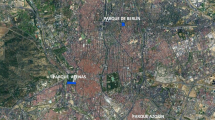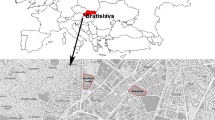Abstract
There is a common belief that contact with nature provides many benefits to humans. Numerous studies on urban vegetation confirm this belief, but the negative effects of excessive exposure to allergenic pollen in urban parks are being more frequently identified. This problem was studied in detail in areas with warm temperate climate conditions. A study of allergenic flora was conducted in 3 types of urban parks: a downtown park, a peripheral park, and a landscape-like park. A total of 90 woody plant species were identified, among which Picea pungens, Tilia cordata, Acer pesudoplatanus, Acer platanoides, Quercus rubra, and Betula pendula were found most frequently. Among the herbaceous plants, Lolium perenne, Poa annua, Achillea millefolium, and Potentilla anserina were predominant. The allergenicity level of these parks was described using an allergenicity index. This study showed that under a warm temperate climate the potential harmful impacts of parks are determined by the number of birches and oaks and their crown volumes, as well as by the total tree canopy. The volume of turf covered with grass species as well as the number of maple and ash trees and their crown volumes are of minor importance. Unlike the downtown parks, the landscape-like park poses the lowest risk to sensitive people. Research on parks that is focused on allergenic flora and allergenic pollen production should be used in designing new parks and in the revitalization of old parks.



Similar content being viewed by others
References
Alcázar, P., Velasco-Jiménez, M. J., Domínguez-Vilches, E., & Galán, C. (2016). A contribution to the study of airborne Citrus pollen in Córdoba, southern Spain. Urban Forestry and Urban Greening, 16, 9–12.
Baniukiewicz, E. (1972). Park w Łańcucie (p. 178). Warszawa: Arkady.
Camacho-Cervantes, M., Schondube, J. E., Castillo, A., & MacGregor-Fors, I. (2014). How do people perceive urban trees? Assessing likes and dislikes in relation to the trees of city. Urban Ecosystem, 17, 761–773.
Cariñanos, P., Adinolfi, C., Díaz de la Guardia, C., De Linares, C., & Casares-Porcel, M. (2016). Characterization of allergen emission sources in urban areas. Journl of Environmental Quality, 45, 244–252.
Cariñanos, P., & Casares-Porcel, M. (2011). Urban green zones and related pollen allergy, a review. Some guidelines for designing spaces with low allergy impact. Landscape and Urban Planning, 101, 205–214.
Cariñanos, P., Casares-Porcel, M., Díaz de la Guardia, C., Aira, M. J., Belmonte, J., Boi, M., et al. (2017). Assessing allergenicity in urban parks, a nature-based solution to reduce the impact on public health. Environmental Research, 155, 219–227.
Cariñanos, P., Casares-Porcel, M., & Quesada-Rubio, J. M. (2014). Estimating the allergenic potential of urban green spaces, a case-study in Granada Spain. Landscape and Urban Planning, 123, 134–144.
Ciferri, E., Torrisi, M., Stafollani, L., & Hruska, K. (2006). Ecological study of the urban allergenic flora of central Italy. Journal of Mediterranian Ecology, 7, 15–21.
Conway, T. M., & Vander Vecht, J. (2015). Growing a diverse urban forest, species selection decisions by practitioners planting and supplying trees. Landscape and Urban Planning, 138, 1–10.
Ćwik, A., Kasprzyk, I., Wójcik, T., Borycka, K., & Cariñanos, P. (2018). Attractiveness of urban parks for visitors versus their potential allergenic hazard: A case study in Rzeszów, Poland. Urban Forestry & Urban Greening, 35, 221–229.
D’Amato, G., De Palma, R., Verga, A., Martucci, P., Liccardi, G., & Lobefalo, G. (1991). Antigenic activity of nonpollen parts (leaves and stems). of allergenic plants (Parietaria judaica and Dactylis glomerata). Annals of Allergy, 67, 421–424.
Dadvand, P., Villanueva, C. M., Font-Ribera, L., Martinez, D., Basagaña, X., Belmonte, J., et al. (2014). Risks and Benefits of green spaces for children, a cross-sectional study of associations with sedentary behavior, obesity, asthma, and allergy. Environmental Health Perspectives, 122, 1329–1335.
de Weger, L. A., Bergmann, K. C., Rantio-Lehtimäki, A., Dahl, A., Buters, J., Déchamp, C., et al. (2013). Impact of pollen. In M. Sofiev & K. C. Bergman (Eds.), Allergenic pollen, a review of the production, release, distribution and health impacts (pp. 161–215). Berlin: Springer. https://doi.org/10.1007/978-94-007-4881-1_6.
Hruska, K. (2003). Assessment of urban allergophytes using an allergen index. Aerobiologia, 19, 107–111.
https://en.tutiempo.net/climate. Accessed July 2018.
Ianovici, N. (2008). Aerobiological monitoring of allergenic flora in Timisoara. Lucrări ştiinţifice, Seria Horticultură. USAMV IASI, 51, 131–136.
Jianan, X., Zhiyun, O., Hua, Z., Xiaoke, W., & Hong, M. (2007). Allergenic pollen plants and their influential factors in urban areas. Acta Ecologica Sinnica, 27, 3820–3827.
Jochner-Oette, S., Stitz, T., Jetschni, J., & Cariñanos, P. (2018). The influence of individual-specific plant parameters and species composition on the allergenic potential of urban green spaces. Forests, 9, 284. https://doi.org/10.3390/f9060284.
Kasprzyk, I. (2011). Time-series analysis of pollen seasons in Rzeszów (SE Poland). In: 1997–2005 with reference to phenology. Rzeszów: Wydawnictwo Uniwersytetu Rzeszowskiego.
Kihlström, A., Lilja, G., Pershagen, G., & Hedlin, G. (2003). Exposure to high doses of birch pollen during pregnancy, and risk of sensitization and atopic disease in the child. Allergy, 58, 871–877.
Kuchcik, M., Dudek, W., Błażejczyk, K., Milewski, P., & Błażejczyk, A. (2016). Two faces to the greenery on housing estates–mitigating climate but aggravating allergy. A Warsaw case study. Urban Forestry and Urban Greening, 16, 170–181.
Lonezoni-Chiesura, F., Giorato, M., & Marcer, G. (2000). Allergy to pollen of urban cultivated plants. Aerobiologia, 16, 313–316.
Martínez-Bracero, M., Alcázar, P., Díaz de la Guardia, C., González-Minero, F. J., Ruiz, L., Trigo Pérez, M., et al. (2015). Pollen calendars: A guide to common airborne pollen in Andalusia. Aerobiologia, 31(4), 549–557.
Maya-Manzano, J. M., Fernández-Rodríguez, S., Monroy-Colín, A., Silva-Palacios, I., Tormo-Molina, R., & Gonzalo-Garijo, Á. (2017a). Allergenic pollen of ornamental plane trees in a Mediterranean environment and urban planning as a prevention tool. Urban Forestry and Urban Greening, 27, 352–362.
Maya-Manzano, J. M., Tormo, Molina R., Fernández Rodríguez, S., Silva Palacios, I., & Gonzalo Garijo, Á. (2017b). Distribution of ornamental urban trees and their influence on airborne pollen in the SW of Iberian Peninsula. Landscape and Urban Planning, 157, 434–446.
Mrđan, S., Ljubojević, M., Orlović, S., Čukanović, J., & Dulić, J. (2017). Poisonous and allergenic plant species in preschool’s and primary school’s yards in the city of Novi Sad. Urban For Urban Green, 25, 112–119.
Nielsen, A. B., van den Bosch, M., Maruthaveeran, S., & van den Bosch, C. K. (2014). Species richness in urban parks and its drivers, a review of empirical evidence. Urban Ecosystem, 17, 305–327.
Nowak, M., Szymańska, A., Grewling, Ł., Jackowiak, B., & Silny, W. (2012). Allergic risk zones of plane tree pollen (Platanus sp.) in Poznań. Postępy Dermatologii i Alergologii, 3, 156–160.
Palliwoda, J., Kowarika, I., & von der Lippe, M. (2017). Human-biodiversity interactions in urban parks: The species level matters. Landscape Urban Planning, 157, 394–406.
Pawankar, R., Holgate, T. G., Canonica, W., Lockey, R. L., & Blaiss, M. S. (Eds.). (2013). WAO white book on allergy 2013 update. World Allergy Organization. http://www.worldallergy.org/wao-white-book-on-allegy. Accessed July 2018.
Peel, R. G., Ørby, P. V., Skjøth, C. A., Kennedy, R., Schlünssen, V., Smith, M., et al. (2014). Seasonal variation in diurnal atmospheric grass pollen concentration profiles. Biogeoscience, 11, 821–832.
Pérez-Badia, R., Rapp, A., Morales, C., Sardinero, S., Galán, C., & García-Mozo, H. (2010). Pollen spectrum and risk of pollen allergy in central Spain. Annals Agriculture and Environmental Medicine, 17, 139–151.
Piotrowska, K. (2008). Pollen production in selected species of anemophilous plants. Acta Agrobotanica, 61, 41–52.
Pretzsch, H., Biber, P., Uhl, E., Dahlhausen, J., Rötzer, T., Caldentey, J., et al. (2015). Crown size and growing space requirement of common tree species in urban centres, parks, and forests. Urban Forestry & Urban Greening, 14(3), 466–479.
Reháčková, T., & Pauditšová, E. (2004). Evaluation of urban green spaces in Bratislava. Boreal Environmental Research, 9, 469–477.
Samoliński, B., Arcimowicz, M., Zawisza, E., & Rapiejko, P. (1996). Hypersensitivity to pollen allergens based on skin tests results in 680 atopic patients. Annals of Agriculture and Environmental Medicine, 3, 179–182.
Seneta, W., & Dolatowski, J. (2008). Dendrologia. Warszawa: Wydawnictwo Naukowe PWN.
Staffolani, L., Velasco-Jiménez, M. J., Galán, C., & Hruska, K. (2011). Allergenicity of the ornamental urban flora, ecological and aerobiological analyses in Córdoba (Spain). and Ascoli Piceno (Italy). Aerobiologia, 27, 239–246.
Ståle, A. (2006). Sociotope mapping: Exploring public open space and its multiple use values in urban and landscape planning practice. Nordic Journal of Architectural Research, 19, 59–71.
Tormo Molina, R., Rodríguez, A. M., Palaciso, I. S., & López, F. G. (1996). Pollen production in anemophilous trees. Grana, 35, 38–46.
van den Bosch, M. (2017). Natural environments, health, and well-being. Research Encyclopedia of Environmental Science. https://doi.org/10.1093/acrefore/9780199389414.013.333.
Velasco-Jiménez, M. J., Arenas, M., Alcázar, P., Galán, C., & Domínguez-Vilches, E. (2015). Aerobiological and phenological study of Pistacia in Córdoba city (Spain). Science Total Environment, 505, 1036–1042.
Vogt, J., Gillner, S., Hofmann, M., Tharang, A., Dettmann, S., Gerstenberg, T., et al. (2017). Citree, a database supporting tree selection for urban areas in temperate climate. Landscape and Urban Planning, 157, 14–25.
Wang, Y., de Groot, R., Bakker, F., Wörtche, H., & Leemans, R. (2017). Thermal comfort in urban green spaces, a survey on a Dutch university campus. International Journal of Biometeorology. https://doi.org/10.1007/s00484-016-1193-0.
Ziaja, M., & Wójcik, T. (2015). Changes in vascular flora of the Rzeszow reservoir after 20 years (SE Poland). Polish Journal of Environmental Studies, 24(4), 185–1845.
Author information
Authors and Affiliations
Corresponding author
Rights and permissions
About this article
Cite this article
Kasprzyk, I., Wójcik, T., Cariñanos, P. et al. Evaluation of the allergenicity of various types of urban parks in a warm temperate climate zone. Aerobiologia 35, 57–71 (2019). https://doi.org/10.1007/s10453-018-9537-3
Received:
Accepted:
Published:
Issue Date:
DOI: https://doi.org/10.1007/s10453-018-9537-3




